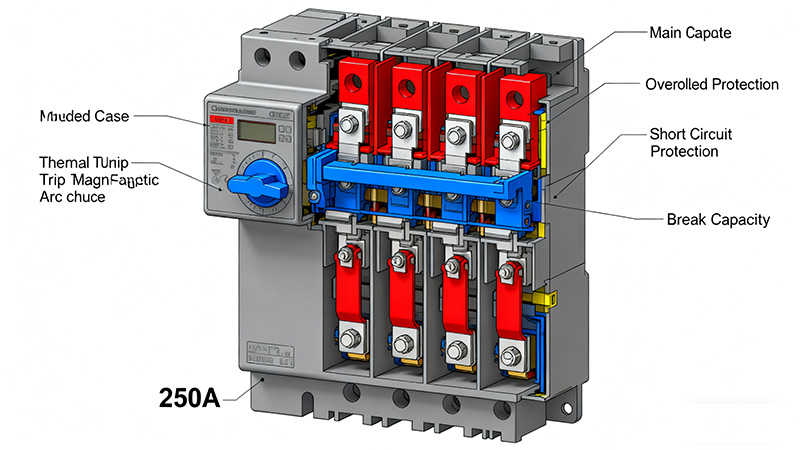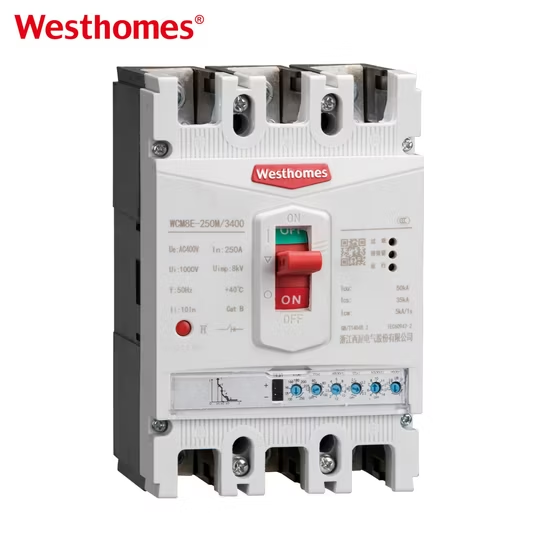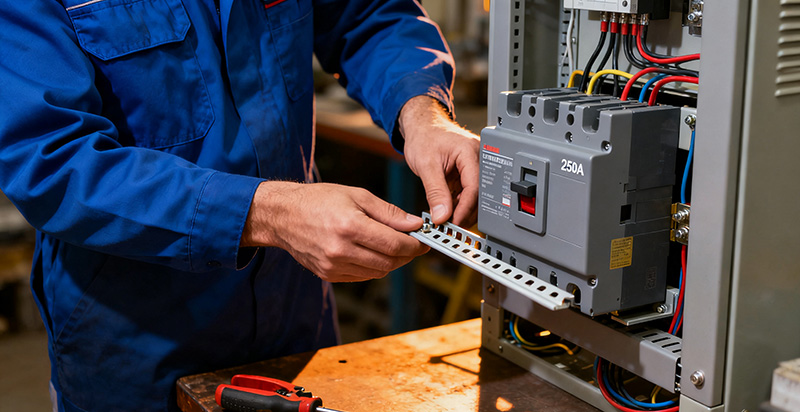When selecting a 250A breaker, one crucial specification to understand is its breaking capacity (also known as interrupting capacity). This term defines the maximum fault current the breaker can safely interrupt without failing.
In practical terms, breaking capacity tells you how large of a short-circuit surge a molded case circuit breaker (MCCB) can handle before it breaks the circuit (trips) and isolates the fault. It’s a key factor for safety and performance.
If a fault occurs that exceeds the breaker’s capability, the breaker itself could be damaged or destroyed. We’ll explain what breaking capacity means for a 250A MCCB, why it matters, typical breaking capacity values for a 250A breaker, and how to choose the right rating for safe and reliable operation.

What Is Breaking Capacity?
Breaking capacity is the highest level of short-circuit current that a circuit breaker can interrupt without being destroyed or causing an unacceptable arc. It’s essentially the fault-handling limit of the breaker.
Breaking capacity is usually measured in kiloamperes (kA) and is specified at a certain voltage (for example, 25 kA at 415 V AC). This means the breaker can safely cut off a short-circuit up to that many thousands of amps.
If a surge higher than that rating occurs, the breaker may not be able to stop it. In other words, the prospective short-circuit current at the installation should never exceed the breaker’s rated capacity, or else safe interruption cannot be guaranteed.
Most MCCBs, including 250A models, have two related ratings: Icu and Ics.
- Icu (ultimate breaking capacity) is the maximum fault current the breaker can interrupt even if it may be damaged afterward.
- Ics (service breaking capacity) is the level of fault current the breaker can interrupt multiple times and still remain operable.
For simplicity, think of Icu as the absolute emergency limit, and Ics as the reliable level for repeated operation. For a 250A breaker, manufacturers often design Ics to be a high fraction (e.g. 50–100%) of Icu, ensuring the device is robust in real-world use.
Why Breaking Capacity Matters?
Breaking capacity is critical for safety. A short-circuit in an electrical system can unleash an enormous current surge in a split second. If the 250A MCCB does not have a high enough breaking capacity for that surge, it may fail to interrupt the current. When a breaker is overstressed by a fault beyond its rating, it can overheat, melt, or even explode, leading to fires or equipment damage.
Choosing an adequate breaking capacity ensures the breaker will trip reliably and safely, protecting both people and equipment. A properly rated 250A breaker will cut off a short-circuit before it causes downstream damage. In high-fault scenarios, a robust breaker minimizes downtime and repair costs by preventing extensive damage.
Typical Breaking Capacity Values for a 250A Breaker
Not all 250A MCCBs have the same breaking capacity. Manufacturers offer different models with various interrupting ratings to suit different environments.
Here are some typical ranges you might encounter:
Around 15 kA (low end): Suitable for small facilities or systems far from the power source where fault currents are very low.
25 to 36 kA (standard range): Common for most commercial and light industrial applications. Many standard 250A breakers are rated in this range and are ideal for typical distribution panels and branch circuits.
50 kA (high capacity): Often used as a main breaker in large commercial or industrial installations. A 50 kA 250A breaker is capable of handling significant fault currents close to transformers or generators.
70–100 kA (very high capacity): Designed for heavy industrial facilities, data centers, or systems with very high available fault currents. These breakers use advanced arc-quenching mechanisms for maximum safety.
Remember, breaking capacity is rated at a specific voltage. A breaker’s kA rating can vary with system voltage. It might handle 50 kA at 240 V but less at 480 V. Always check the datasheet for ratings at your operating voltage.




